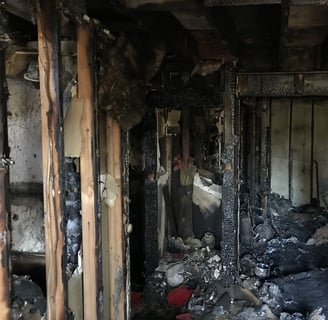Do I need a structural engineer for fire damage?
3 min read


Here’s why you might need a structural engineer for fire damage:
1. Assessing Structural Integrity After Fire Damage
Why: Fire can weaken or completely destroy load-bearing components such as beams, columns, floor joists, and roof trusses. In some cases, even if the damage is not immediately visible, fire can cause internal weakening of the structure, such as wood components or steel framing. This can make the building unsafe to enter or inhabit.
Action: A structural engineer will evaluate the extent of the structural damage, including:
Load-bearing walls and columns that may have been weakened.
Beams and rafters that could have suffered heat damage or warping.
Foundations that might have been affected by heat or shifts due to fire-related movement.
Potential issues with steel framing, as intense heat from fire can reduce steel’s strength.
2. Identifying Hidden Damage
Why: Fire doesn’t just damage what is visible on the surface. It can cause hidden structural damage that is not immediately apparent. For example, the heat from a fire can warp or crack wood beams, weaken metal structures, or cause foundation shifts. Smoke damage can also impact the structural elements by causing moisture accumulation or corrosion in the long term.
Action: A structural engineer can identify and evaluate:
Internal damage to framing, beams, and columns that might not be easily visible from the outside.
Hidden cracks, shifts, or compromised structural connections that may have been caused by the heat of the fire.
Smoke or chemical damage to materials that can lead to further weakening over time.
3. Ensuring Safety and Stability
Why: After a fire, the building may not be safe to enter or inhabit, especially if load-bearing components have been damaged. A building that has suffered fire damage could be at risk of collapse or further structural degradation if not properly evaluated.
Action: The structural engineer will assess whether the building is stable and safe to occupy. They will check for:
Structural deformation (e.g., warped beams or sagging floors).
Cracked foundations or shifting that may have occurred as a result of the fire’s heat.
Structural movement caused by fire, which may continue after the fire is out.
The engineer will recommend temporary stabilization if necessary to prevent further damage or collapse.
4. Documenting Damage for Insurance Claims
Why: Insurance companies typically require detailed documentation to process claims, especially for significant damage like fire. A structural engineer’s assessment provides objective, expert documentation of the structural damage, which can help ensure you receive a fair settlement.
Action: The structural engineer will provide a report that:
Describes the extent of fire damage to load-bearing components.
Includes photographs, drawings, and measurements to visually document the damage.
Outlines safety concerns and necessary repairs.
Offers recommendations for repair or replacement of damaged structural elements.
5. Recommendations for Repairs
Why: After assessing the damage, a structural engineer will recommend appropriate repairs to restore the building’s structural integrity. Some fire damage may require specialized repair methods, particularly if it involves load-bearing elements like beams or columns.
Action: The engineer will provide recommendations for:
Reinforcing or replacing damaged beams, columns, or trusses.
Repairing foundation cracks or shifts caused by the fire.
Ensuring repairs are up to code and prevent future risks related to fire or structural failure.
6. Ensuring Code Compliance for Repairs
Why: Any repairs made to a building after a fire must comply with local building codes, which are designed to ensure safety and structural integrity. A structural engineer will ensure that the necessary repairs meet all current safety standards and building codes, including fire-resistant materials or storm-resistant features.
Action: The engineer will ensure that the repairs are designed and executed in compliance with local building codes, ensuring the building is structurally sound and up to code after the fire.
7. Resolving Disputes with the Insurance Adjuster
Why: In some cases, the insurance company may not fully recognize the extent of the structural damage or may underestimate the repair costs. A structural engineer can help resolve these disputes by providing an independent expert assessment of the damage.
Action: If you are having trouble getting a fair settlement from the insurance company, the engineer’s report can provide critical documentation to support your case and ensure you receive appropriate compensation for the necessary repairs.
When to Call a Structural Engineer for Fire Damage:
Extensive structural damage: If the fire has caused significant damage to load-bearing beams, roof trusses, foundation, or structural supports.
Hidden damage: If you suspect fire damage has affected structural components that are not visible, such as internal framing, foundations, or metal supports.
Safety concerns: If there are signs of instability, such as sagging floors, cracked walls, or uneven foundations.
Disputes with the insurance company: If the insurance company underestimates the damage or the cost of repairs.
Specialized repairs needed: If the fire has caused damage that requires specialized repairs to structural components, such as replacing or reinforcing beams or foundations.
Long-term safety concerns: If the fire has left structural components vulnerable to future degradation or instability.
Contact Us
Get in touch with our team of professional engineers to discuss your project requirements or to request more information about our services.
(407) 901-0133
Contact Us
Address
Preeminent Solutions
P.O. Box 206, Sanford, FL, 32773
